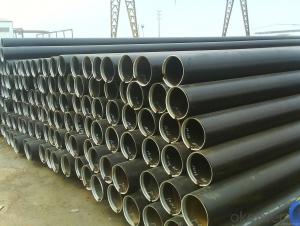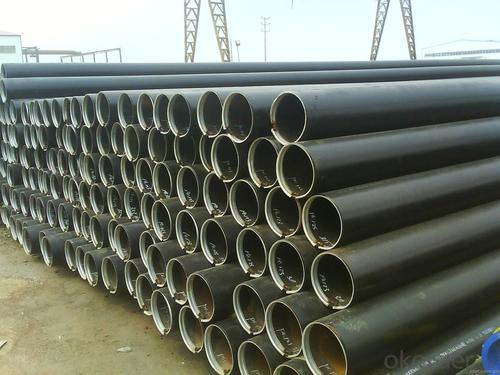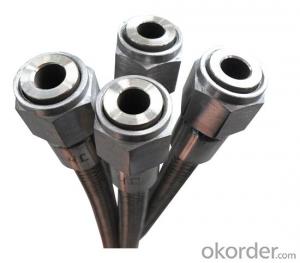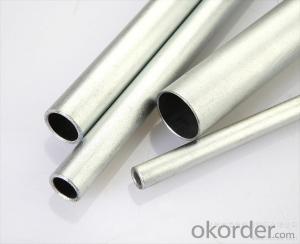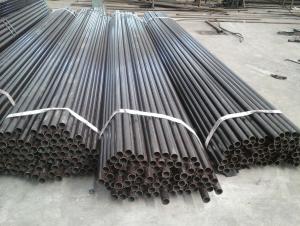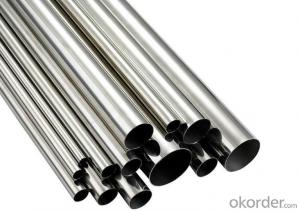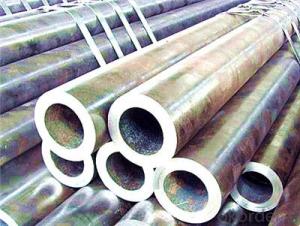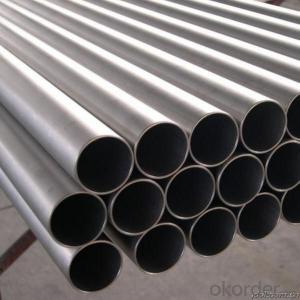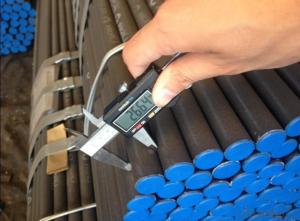ASTM53 Cold Drawn Stainless Steel Pipe Made in China
- Loading Port:
- Tianjin
- Payment Terms:
- TT OR LC
- Min Order Qty:
- 35 m.t
- Supply Capability:
- 5000 m.t/month
OKorder Service Pledge
OKorder Financial Service
You Might Also Like
Specification
Structure :
Seamless pipe is formed by drawing a solid billet over a piercing rod to create the hollow shell. As the manufacturing process does not include any welding, seamless pipes are perceived to be stronger and more reliable. Historically seamless pipe was regarded as withstanding pressure better than other types, and was often more easily available than welded pipe.
Main Features :
• High manufacturing accuracy
• High strength
• Small inertia resistance
• Strong heat dissipation ability
• Good visual effect
• Reasonable price
Specification:
1) Material:20#(ASTM A 106/A53 GRB.API5LGRB,GB),45#,16Mn,10#.
2) Specification range:OD:21.3-610mm,WT:6-70mm,length:6-12m or according to the requirement of clients.
3) Excutive standards:GB,ASME API5L.ASTM A 106/A53,Despite of the above standards,we can also supply seamless steel pipe with standard of DIN,JIS,and so on,and also develop new products according to the requirements of our clients!
4) Surface:black lacquered,varnish coating or galvanized.
5) Ends:Beveled or square cut,plastic capped,painted.
6) Packing:bundles wrapped with strong steel strip,seaworthy packing.
FAQ :
A. How is the quality of your products?
Our products are manufactured strictly according to national and internaional standard, and we take a test on every pipe before delivered out. If you want see our quality certifications and all kinds of testing report, please just ask us for it.
Guaranteed: If products’ quality don’t accord to discription as we give or the promise before you place order, we promise 100% refund.
B. How about price?
Yes, we are factory and be able to give you lowest price below market one, and we have a policy that “ for saving time and absolutely honest business attitude, we quote as lowest as possible for any customer, and discount can be given according to quantity”,if you like bargain and factory price is not low enough as you think, just don’t waste your time.Please trust the quotation we would give you, it is professional one.
C.Why should you chose us?
Chose happens because of quality, then price, We can give you both.Additionally, we can also offer professional products inquiry, products knowledge train(for agents), smooth goods delivery, exellent customer solution proposals.Our service formula: good quality+good price+good service=customer’s trust
SGS test is available, customer inspection before shipping is welcome, third party inspection is no problem.
Any question, pls feel free to contact us !
Product image:
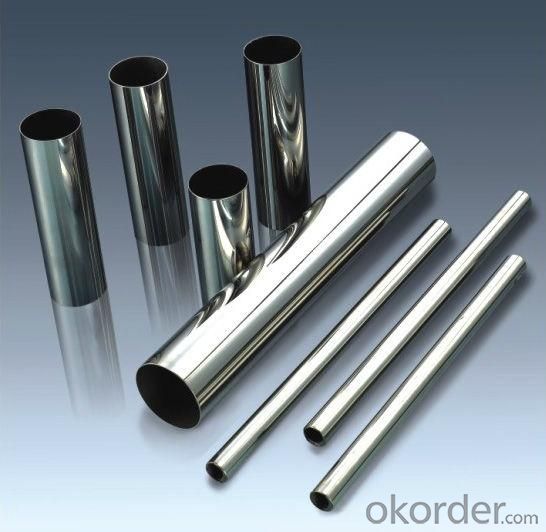
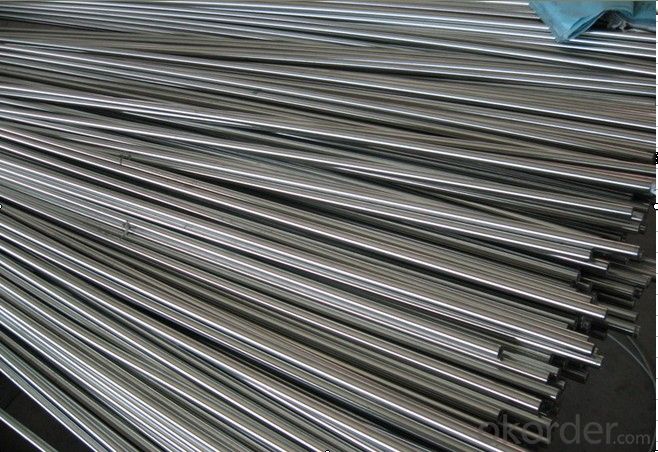
Company Information:
CNBM International Corporation (CNBM International) is the most important trading platform of CNBM Group Corporation, a state-owned company under the direct supervision of State-owned Assets Supervision and Administration Commission of the State Council.
Since 2004, the trading volume of CNBM International has been doubled in 5 successive years owing to the support of superior corporations and effort of all staff. Meanwhile, we have established strategic partnerships with hundreds of domestic manufacturers and sound business relations with clients from over 120 countries. Currently, we have wholly-owned overseas subsidiaries and branches in 5 countries with a view to realize localization, which also represents an essential progress in our globalization target.
In line with the business, CNBM International launched E-business platform Okorder.com.Our goal is to transform CNBM International into the global leading brand in building materials industry within 3 to 5 years through innovation and reform, by strengthening the overall management of supply chain, developing and cultivating both domestic and overseas market, improving the procedure and information system, enhancing the ability to organize resources and to provide value-added services under a professional team and a learning organization.
- Q: Can stainless steel pipes be used for dairy industries?
- Yes, stainless steel pipes can be used for dairy industries. Stainless steel is a popular choice for piping in dairy industries due to its many desirable properties. Stainless steel pipes are corrosion-resistant, which is crucial in the dairy industry where exposure to acids and other corrosive substances is common. They are also easy to clean and maintain, which is important for maintaining hygienic conditions in dairy processing plants. Additionally, stainless steel pipes are non-reactive, meaning they do not interact with the dairy products and alter their taste or quality. Furthermore, stainless steel pipes have high strength and durability, making them suitable for the high-pressure and high-temperature conditions often found in dairy processing. Overall, stainless steel pipes are a reliable and efficient choice for the dairy industry.
- Q: Advantages and disadvantages of PPR lined stainless steel pipe and PPR aluminium plastic pipe
- 1 、 excellent resistance to temperature and pressurePP-R tube and aluminum layer organic combination, with higher strength and better temperature resistance, pressure resistance performance, more suitable for high temperature hot water field use2, small thermal expansion deformationThe thermal expansion coefficient is small (3 x 10-5m/m - C), similar to metal pipe, avoid the pipe deformation due to temperature changes, reduce the number of free arm compensation for pipe deformation, is ideal for heating and central air-conditioning system.3, light blocking oxygenThe intermediate aluminum layer is insulated from oxygen to avoid the oxidation and corrosion of the metal parts in the heating and central air conditioning system, thus effectively prolonging the service life of the system.
- Q: Stainless steel why rust?
- The surface of stainless steel deposited dust or heterogeneous metal particles containing other metal elements of the attachment, in the humid air, condensed water and adhesion between the stainless steel, the two together into a micro battery, causing the electrochemical reaction, the film has been destroyed, called electrochemical corrosion.
- Q: Can stainless steel pipes be used for wastewater treatment plants?
- Yes, stainless steel pipes can be used for wastewater treatment plants. Stainless steel is highly resistant to corrosion and can withstand the harsh and corrosive environment of wastewater treatment plants. It is a durable and reliable material that can effectively transport and handle wastewater without degradation or contamination.
- Q: What are the common applications of stainless steel pipes?
- Due to their exceptional qualities, stainless steel pipes find widespread use across various industries. They are highly regarded for their corrosion resistance, durability, and ability to withstand high pressure and temperature. Here are some of the common applications of stainless steel pipes: 1. Plumbing and Water Systems: Stainless steel pipes are commonly employed in plumbing and water supply systems due to their ability to resist corrosion, durability, and capacity to handle high pressure and temperature. 2. Oil and Gas Industry: The oil and gas industry heavily relies on these pipes for the transportation of petroleum products. This is because stainless steel pipes exhibit high resistance to corrosion and possess excellent strength, enabling them to endure extreme temperatures and harsh conditions. Consequently, they prove ideal for offshore drilling and pipeline systems. 3. Food and Beverage Industry: The food and beverage industry extensively utilizes stainless steel pipes for the transportation of liquids and gases. These pipes are favored for their hygienic properties, resistance to corrosion, and ease of cleaning. They are frequently employed in dairy plants, breweries, and food processing units. 4. Pharmaceutical Industry: In the pharmaceutical industry, sterile conditions are essential when transporting chemicals, gases, and liquids. Stainless steel pipes are indispensable in this sector due to their corrosion resistance and capability to withstand high temperatures. 5. Construction and Architecture: Stainless steel pipes serve a multitude of purposes in construction and architecture, particularly for structural applications. They are utilized for handrails, balustrades, structural supports, and decorative elements. The aesthetic appeal, durability, and corrosion resistance of stainless steel pipes make them highly sought after. 6. Automotive Industry: The automotive industry relies on stainless steel pipes for numerous applications, including exhaust systems, fuel lines, and structural components. The high temperature resistance and durability of stainless steel make it a suitable choice for these demanding tasks. 7. Chemical Industry: The chemical industry extensively employs stainless steel pipes for the transportation of corrosive chemicals and gases. Their resistance to corrosion and ability to withstand high temperatures make them well-suited for chemical processing plants and refineries. 8. Marine Industry: The marine industry extensively utilizes stainless steel pipes due to their ability to resist corrosion caused by saltwater. They are crucial components in shipbuilding, offshore platforms, and underwater pipelines. Overall, stainless steel pipes are invaluable in industries that prioritize corrosion resistance, high temperature resistance, durability, and hygiene. Their versatility and reliability have made them the preferred choice across various industries worldwide.
- Q: Can stainless steel pipes be used for pharmaceutical cleanrooms?
- Yes, stainless steel pipes can be used for pharmaceutical cleanrooms. Stainless steel is a preferred material in pharmaceutical cleanrooms due to its excellent corrosion resistance, durability, and ease of cleaning. It meets the stringent requirements for clean and sterile environments and can withstand the harsh cleaning agents used in pharmaceutical facilities.
- Q: How much is one ton of stainless steel pipe?
- First of all, to determine the use of your stainless steel pipe, and now mainly with 304 stainless steel and 316L stainless steel,304 moderate price, good rust resistance, suitable for daily home decoration.
- Q: What is the difference between 304LN and 316LN stainless steel pipes?
- The main difference between 304LN and 316LN stainless steel pipes lies in their chemical composition and corrosion resistance properties. 304LN stainless steel pipes contain a higher percentage of chromium and nickel, making them more resistant to corrosion in general applications. On the other hand, 316LN stainless steel pipes have a higher content of molybdenum, which enhances their resistance to pitting and crevice corrosion, especially in chloride environments. Therefore, 316LN stainless steel pipes are often preferred in more corrosive and aggressive environments, such as marine or coastal applications, while 304LN stainless steel pipes are suitable for regular industrial and commercial use.
- Q: What are the different grades of stainless steel used in pipes?
- There are several different grades of stainless steel that are commonly used in pipes, each with its own unique properties and characteristics. The most commonly used grades include: 1. Stainless Steel Grade 304: This is one of the most versatile and widely used grades of stainless steel. It is non-magnetic, has excellent corrosion resistance, and is easily weldable. Grade 304 is commonly used in applications where hygiene and cleanliness are important, such as in food processing plants, hospitals, and pharmaceutical industries. 2. Stainless Steel Grade 316: This grade is known for its superior corrosion resistance, especially in environments with high chloride content or exposure to saltwater. Grade 316 is often used in marine applications, chemical processing plants, and coastal areas where corrosion resistance is crucial. 3. Stainless Steel Grade 321: Grade 321 is stabilized with titanium, making it more resistant to sensitization and intergranular corrosion at elevated temperatures. It is commonly used in high-temperature applications, such as exhaust systems, furnaces, and heat exchangers. 4. Stainless Steel Grade 409: This grade is specifically designed for high-temperature applications, such as automotive exhaust systems. It has excellent heat resistance and low thermal expansion properties, making it ideal for withstanding extreme temperatures. 5. Stainless Steel Grade 904L: Grade 904L has high corrosion resistance and is particularly resistant to pitting and crevice corrosion. It is commonly used in aggressive environments, such as chemical processing plants, offshore oil and gas platforms, and pulp and paper industries. These are just a few examples of the different grades of stainless steel used in pipes. The choice of grade depends on the specific application and the desired properties, such as corrosion resistance, temperature resistance, and mechanical strength.
- Q: How do you prevent pitting corrosion in stainless steel pipes?
- To prevent pitting corrosion in stainless steel pipes, several measures can be taken: 1. Choose the right grade of stainless steel: Not all stainless steels are created equal. Opt for grades with a higher resistance to corrosion, such as 316 or 904L, which contain molybdenum and have better resistance to pitting corrosion. 2. Adequate alloying elements: Ensure that the stainless steel pipe contains the proper amount of alloying elements, such as chromium and molybdenum. These elements form a protective layer on the surface of the steel, making it more resistant to corrosion. 3. Regular cleaning and maintenance: Regularly clean the stainless steel pipes to remove any contaminants or deposits that could lead to pitting corrosion. Avoid using abrasive materials or cleaners that may damage the protective layer of the steel. 4. Avoid exposure to aggressive environments: Limit the exposure of stainless steel pipes to aggressive substances like chloride ions, acidic solutions, or high temperatures, as these can accelerate pitting corrosion. If exposure is unavoidable, consider using protective coatings or linings to create a barrier between the steel and the corrosive environment. 5. Cathodic protection: Implement cathodic protection techniques, such as sacrificial anode systems or impressed current systems, to protect stainless steel pipes. These methods create a potential difference between the stainless steel and a more easily corroded metal, redirecting corrosion away from the stainless steel. 6. Control water chemistry: In applications involving water, monitor and control the water chemistry parameters such as pH, temperature, and chloride levels. Adjusting these factors within acceptable limits can help prevent pitting corrosion in stainless steel pipes. 7. Implement proper design and installation practices: Ensure that stainless steel pipes are designed and installed correctly, considering factors such as avoiding crevices, proper drainage, and avoiding stagnant areas where corrosion can occur. Proper insulation and the use of gaskets or flanges made from compatible materials can also prevent pitting corrosion. By following these preventive measures, you can significantly reduce the risk of pitting corrosion in stainless steel pipes, extending their lifespan and maintaining their structural integrity.
Send your message to us
ASTM53 Cold Drawn Stainless Steel Pipe Made in China
- Loading Port:
- Tianjin
- Payment Terms:
- TT OR LC
- Min Order Qty:
- 35 m.t
- Supply Capability:
- 5000 m.t/month
OKorder Service Pledge
OKorder Financial Service
Similar products
Hot products
Hot Searches
Related keywords
